Derek Eder
Civic Tech Builder

I use data, build tools, and organize people in Chicago to democratize power. Read more »
 DataMade
DataMade
Founder and Partner
 Village of Oak Park
Village of Oak Park
Trustee
 Chi Hack Night
Chi Hack Night
Co-Founder and President Emeritus
Wanna talk? Email me
Electrifying Our Old Oak Park Home #1: Going Solar
Published on Nov 1, 2022
This is Part 1 of my series Electrifying Our Old Oak Park Home. Read the rest here.
As bad news about climate change continues to frequent the headlines, it can feel hopeless. What could we, a single household, possibly do to make a meaningful contribution to such a huge, global problem? Should we recycle more? Stop eating meat? Stop using plastic bags?
We’re often told these kinds of actions help. But if we step back and look at the bigger picture, it becomes clear that these kinds of efficiency and lifestyle changes won’t be enough. Climate scientists and the UN have told us we need to get to net zero emissions by 2050. Is there anything more we could possibly be doing to ensure a more sustainable future for our kids?
The answer, if you haven’t guessed already, is yes — we can do more. In January of this year, my friend Juan-Pablo Velez gave a talk on fighting climate change via electrification. I’d heard of electric vehicles and thought they seemed like something I’d switch to eventually, but what I hadn’t considered until then was everything else in my home that uses fossil fuels: our gas furnace, our gas hot water heater, our gas stove and our gas clothes dryer.
Taken individually, these small appliances don’t contribute much to climate change, but if you look at all the 5 million buildings in Illinois, a full 15% of our state’s total emissions come from appliances like these.
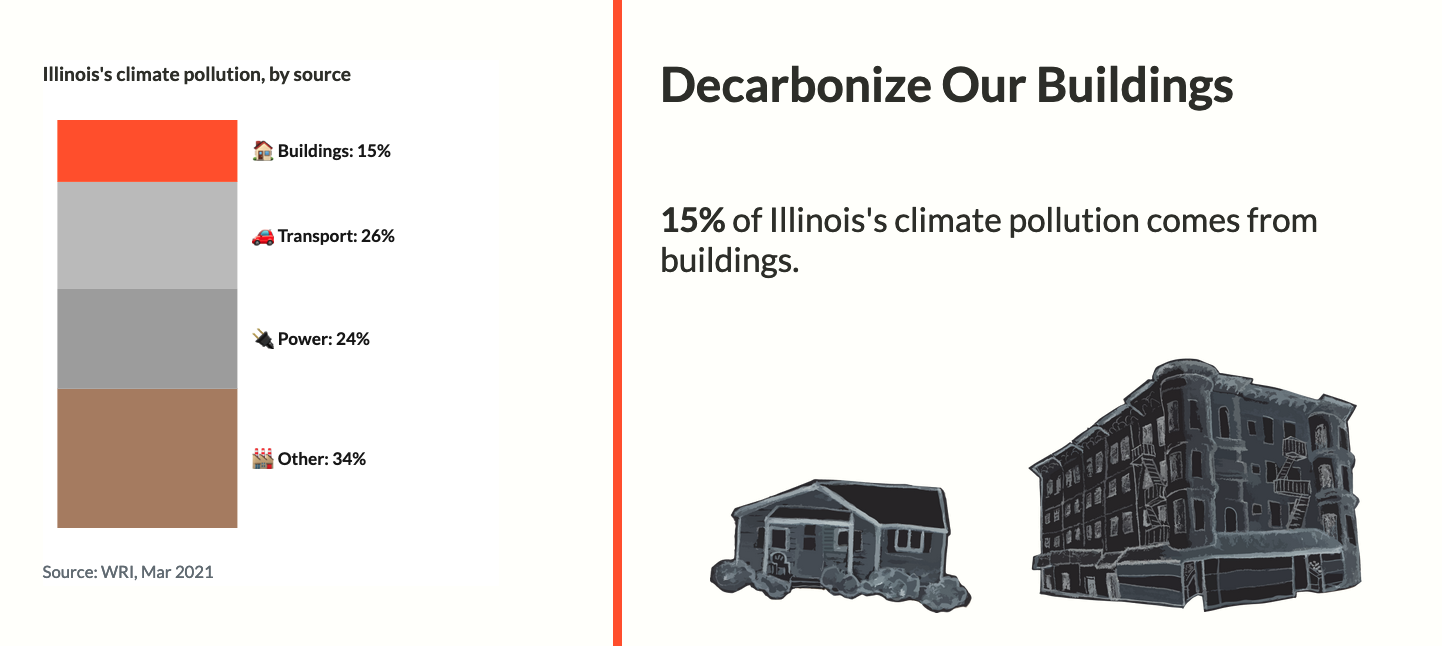
Illinois climate pollution by source, from decarbmystate.com
But that’s not all! Even our electric appliances are drawing power from ‘dirty’ sources. 24% of Illinois’ emissions come from the coal, oil, and natural gas power plants in our state that generate our electricity.
As a homeowner, there are significant steps I can take to do my part in eliminating my own personal climate pollution: replace our appliances with electric ones and generate free, clean energy with rooftop solar panels.
And here’s the good news: electric versions of all appliances already exist, they’re comparable in cost to their gas counterparts, and they will likely reduce your utility bills and improve the air quality in your home. Additionally, the recently passed Inflation Reduction Act (IRA) provides huge incentives on these purchases, making them even more cost-effective.
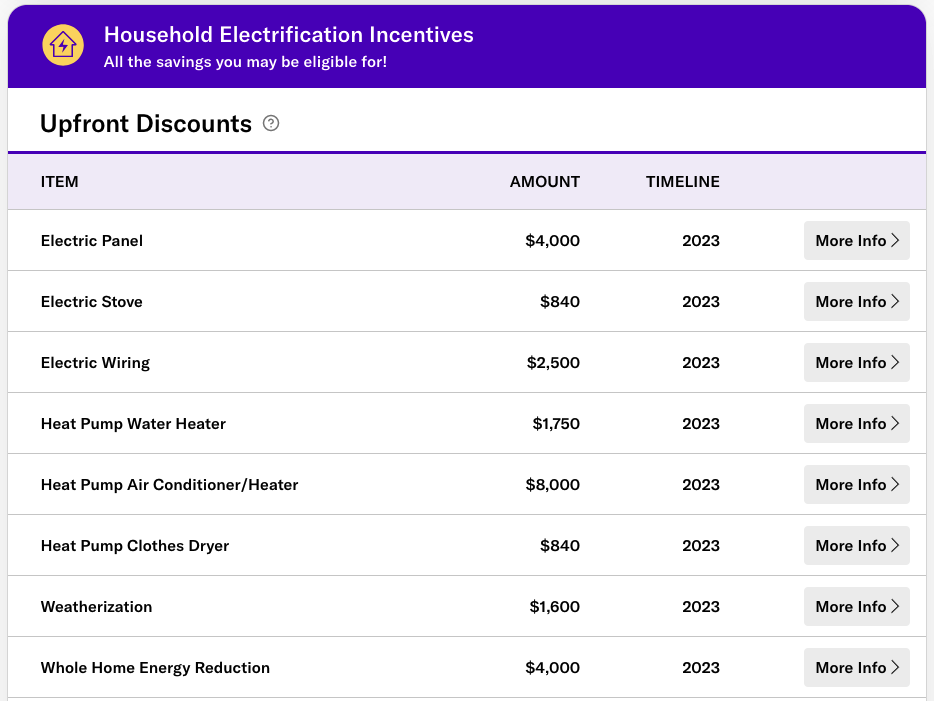
Check out Rewiring America’s IRA Calculator to find out how much you can save when electrifying your home!
We are in the process of doing just that: electrifying our Oak Park home and completely eliminating all our household emissions. We don’t need to wait for some new technology to be invented, or some new program to make this transition. We can start now, and do our part to save the planet, improve our quality of life, and save money in the long run.
This post is an attempt to document our process as we go, with the hopes that it will inspire our neighbors to do the same and learn from our efforts.
Note: Before we dive in, it’s worth noting that, so far, this project cost us about $12,000 up-front after all the rebates, grants and incentives. It will pay for itself in 9 years, and then make money for us after that. Still, there are other incentives available that could reduce this price even further, especially the Illinois Solar for All program, which provides large grants for solar projects if you make less than 80% of the area median income ($83,000/year for a family of four in Cook County).
Table of contents
- Where to begin?
- Starting with solar
- Getting a new roof
- Installing the solar panels
- Monitoring the system
- Bottom line costs and payback period
- Lessons learned
- For the policy folks
- Resources
Where to begin?
We’re not the first people to want to electrify our home, and thankfully there are already a lot of resources that can help guide the way. One of them is Rewiring America’s Electrify Everything Home Guide, a free PDF that outlines the steps to electrify your home.
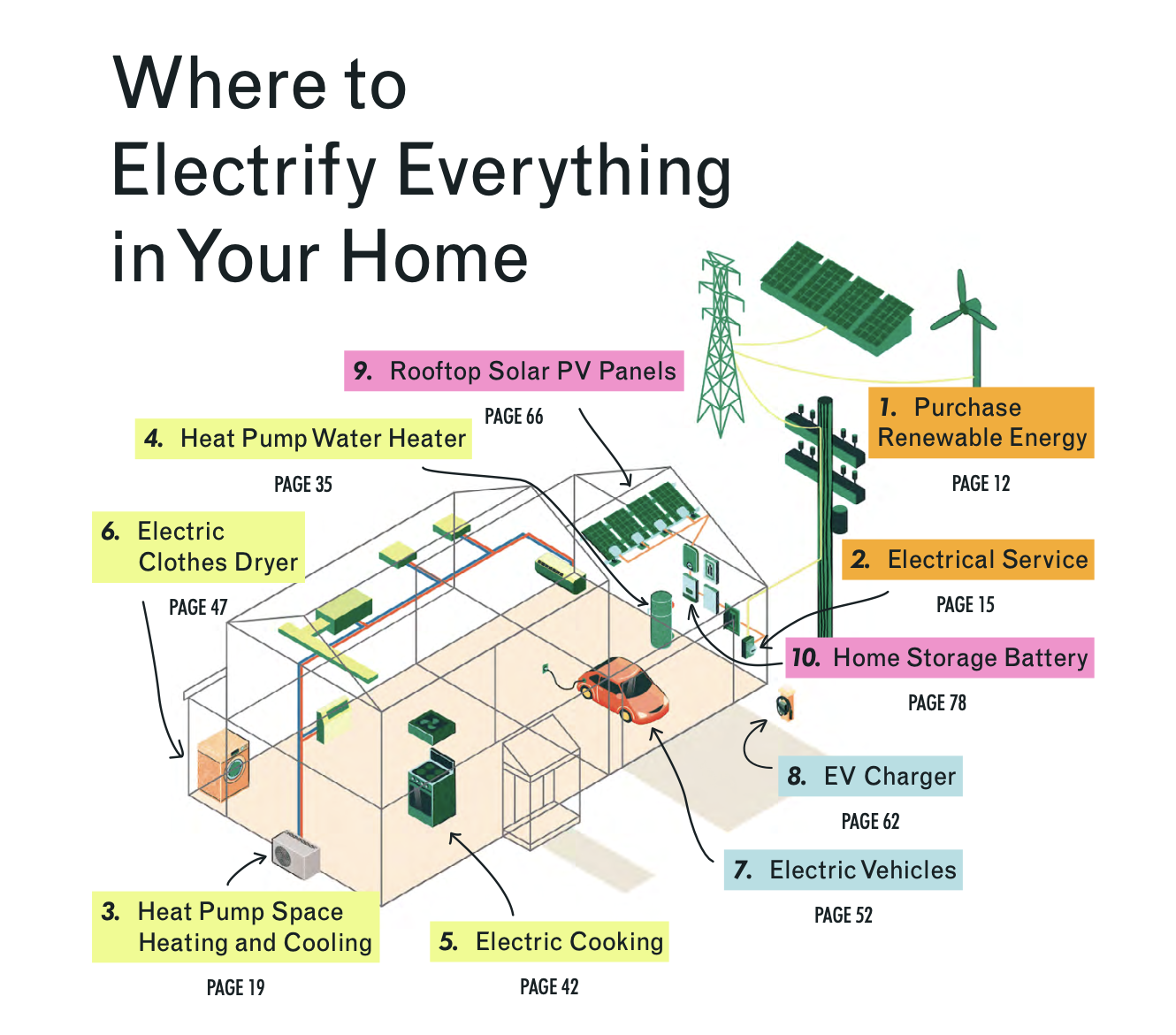
Rewiring America’s Electrify Everything Home Guide
If you’re like me and not an expert on HVAC or home upgrades, you’ll find this guide a great place to start. The guide provides a checklist of actions, a timeline, and the expected cost, complexity, savings and emissions reduction of each step. Use this guide to plan out your upgrades, which may take several months or several years, and tackle the ones that make the most sense for you.
Starting with solar
We decided to eliminate the dirtiest energy our house was already using by installing solar panels on our roof. We found a tool by Google called Project Sunroof, which uses satellite imagery to determine the solar potential of our home.
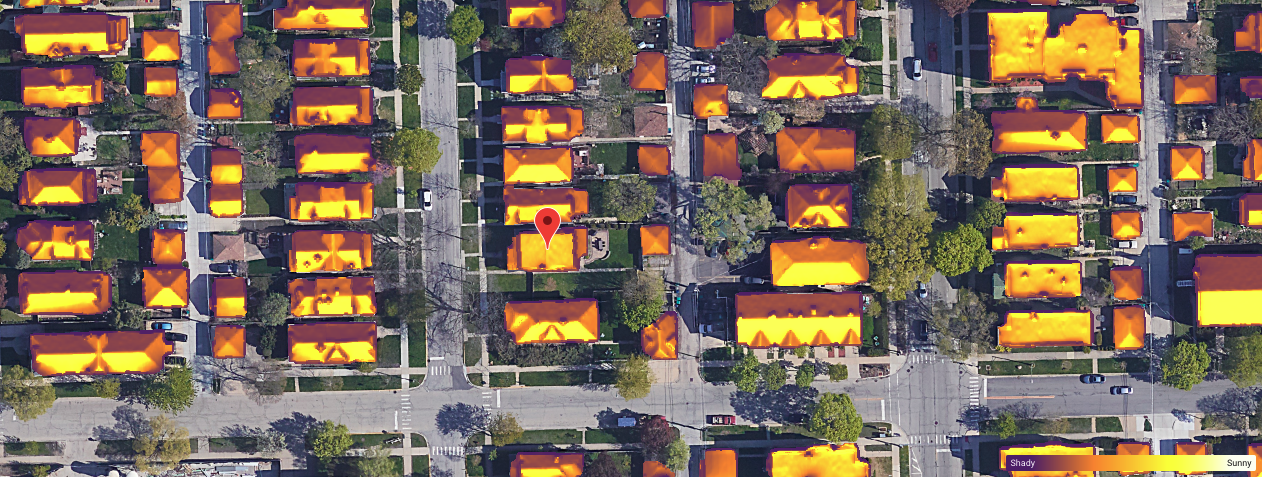
The solar potential of our block with Project Sunroof
It turns out, we have a nice, flat roof with no large trees obstructing our sunlight. According to Project Sunroof, we could install up to a 10.3 kilowatt system, covering 99% of our energy usage with a total savings of $21,000 over 20 years if we pay for everything up front (leasing or getting a loan are also options).
It’s worth noting there was an upfront cost to this project. Project Sunroof estimated $22,000 up-front, our actual all-in number was around $12,000, including a new roof and a new 200 amp electrical box. Keep reading to learn about all the savings and credits we found.
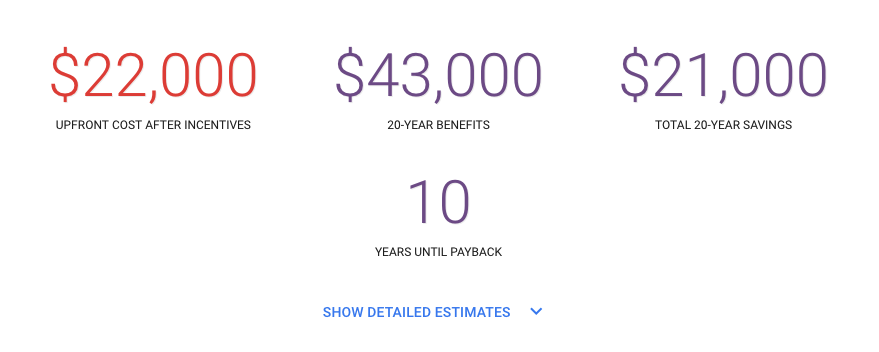
Our solar panel estimate from Project Sunroof
We received bids from multiple solar installers. It turns out there are quite a few that operate in our area, so we started a document listing out all our vendors, which you’re welcome to reference: https://bit.ly/electrify-your-oak-park-home
We decided to go with Ailey Solar as their bid was the most affordable and our neighbors had worked with them. They recommended we install 24 REC Alpha panels totalling 8.76 kilowatts and, in anticipation of using more electricity, to upgrade our electric panel from 100 amps to 200 amps. By including this upgrade with our solar panel installation, it would be covered under the 26% federal tax rebate (more on the final costs below).

Our estimate from Ailey Solar
We thought we were off to the races. But it was during their initial inspection that we hit our first snag.
Getting a new roof
The inspection revealed that our roof was in bad shape. We moved into this home about four years ago and our inspector mentioned at the time our roof was near the end of its 20-year life. Now, it was time to replace it. Solar panels last from 20-30 years, so timing a new roof with installing panels is pretty common. Additionally, most solar installers are expected to certify their work for a certain period of time, and will not be willing to do so unless the roof meets a certain quality.
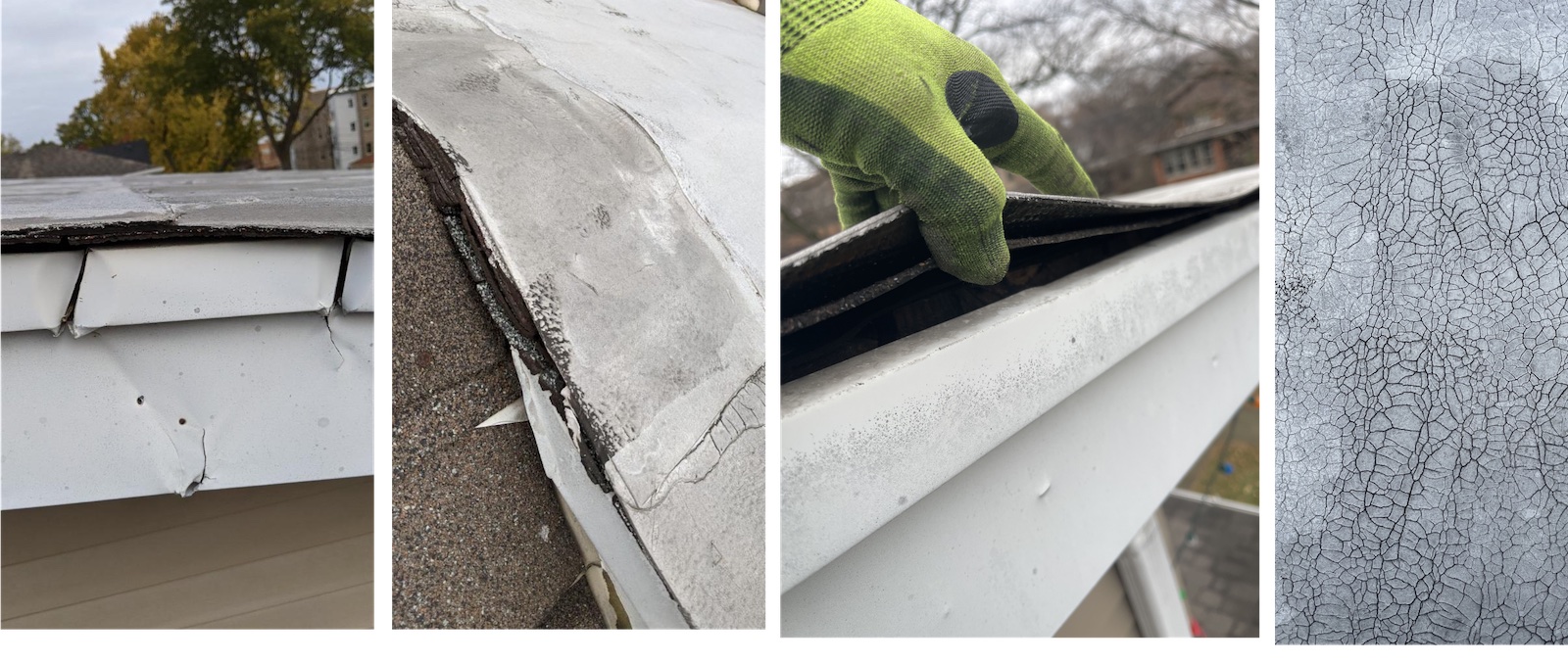
Inspection photos of our old roof
We found a company called Blue Sky Roofing. It was December, so we had to wait a few months for the temperature to be above freezing, but as soon as spring hit, they were able to get started. While they were redoing the roof, we decided to add an inch of insulation to better manage the temperature on our second floor, which was always an issue with the add-on storey. I’ll follow up on this in a future post, but it turns out this was a missed opportunity to insulate our attic space even further.
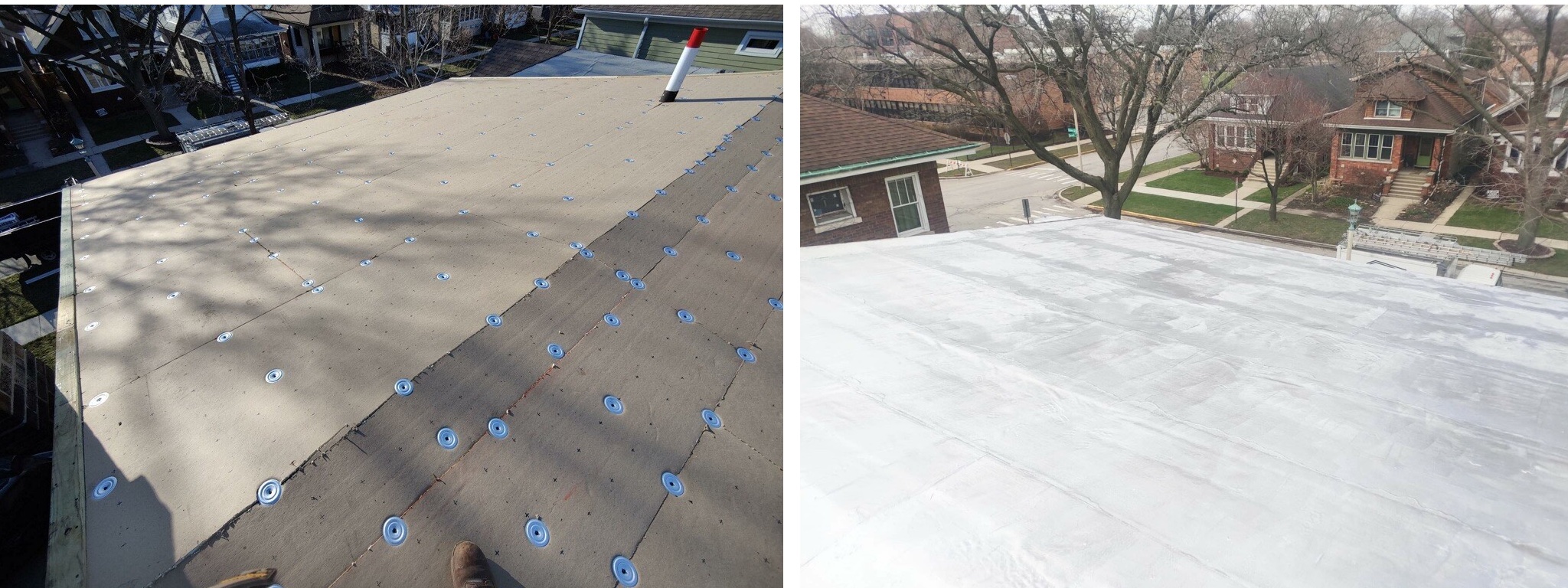
Our new roof with one inch of insulation
After the new roof was completed, Ailey Solar coordinated a structural certification from an engineer to confirm our roof could handle the additional weight of the solar panels and obtained a work permit from the Village of Oak Park to upgrade our electrical panel and install a new ‘smart’ electric meter.
Installing the solar panels
Installation by Ailey Solar took 2 ½ days. During that time we were able to keep the power on at our house for most of the time, with a few interruptions as they ran the new electrical service line.

Our 8.76 kilowatt system of 24 solar panels
After the work was completed, the Village did a final inspection and we were ready to turn on the system. One final step remained: we had to wait for ComEd, our electricity provider, to approve our project and allow our excess solar energy to flow back into the grid, a process that can take up to 14 days.
This is one of the cool things about how Illinois (and many other states) incentivizes installing solar panels. When the sun is shining, we produce more electricity than we use. When this happens, ComEd gives us a credit for this energy. When the sun isn’t shining, especially during the winter months, we draw more electricity from the grid than what we can produce. Over the course of a year, these credits and uses balance out. We essentially get to treat the electric company as a huge battery, storing our excess electricity and drawing it down when we need it later. This is referred to as Net metering and it’s pretty cool!
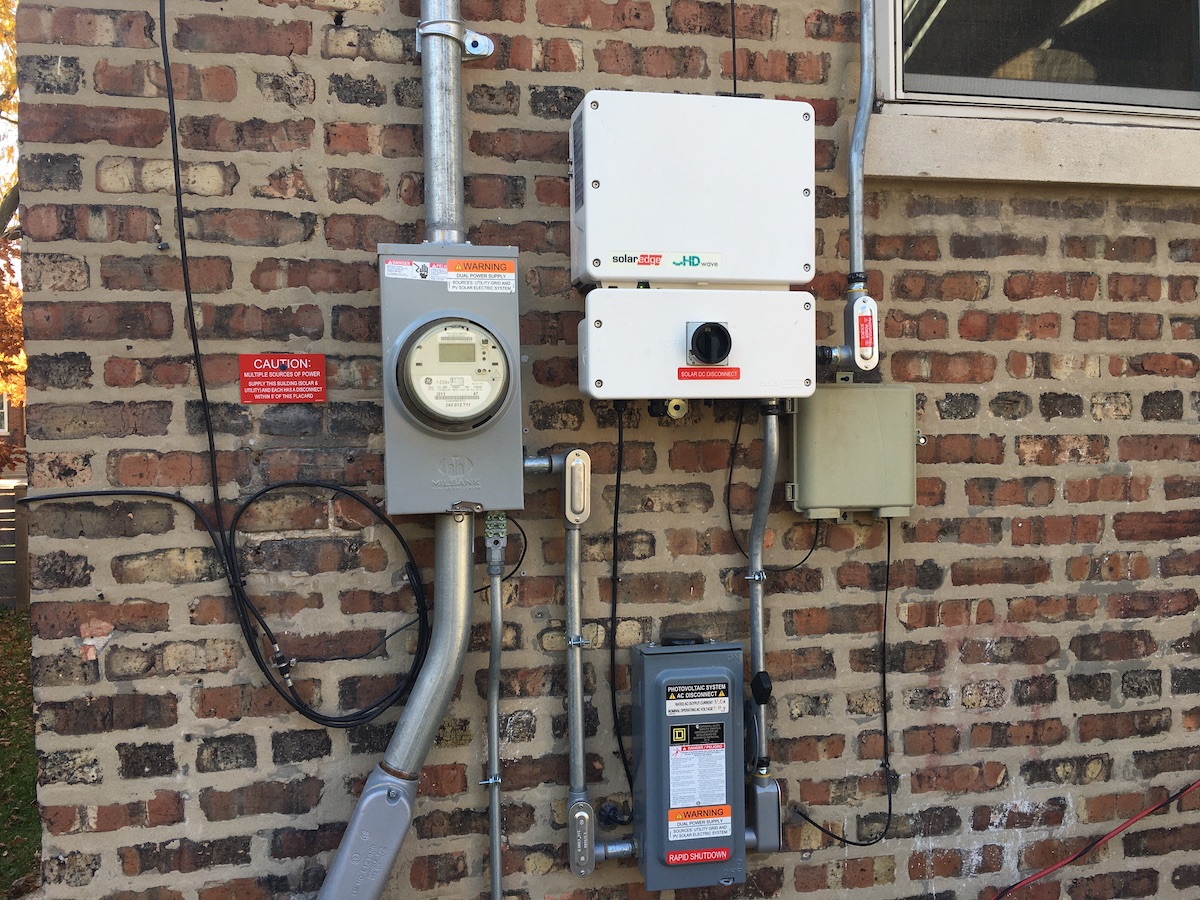
Our new smart meter, SolarEdge box, and external cutoff switch
Monitoring the system
To keep tabs on our solar energy production, a SolarEdge box was installed along with our panels. This box monitors the output of the solar panels and reports everything to a dashboard that we have access to. It allows us to see exactly how much energy we are producing, and compare it to the credits we’re getting from ComEd. You can really see the difference between a sunny and cloudy day in solar energy production!

Monitoring our system using SolarEdge. Left: our daily solar production. Right: the wattage output of each of our 24 panels
Bottom line costs and payback period
Our solar panels have been active since July 11, 2022, and since then, we haven’t paid an electric bill due to the energy credits we’re getting. We still get charged a $15 ‘delivery’ fee each month to be connected to ComEd, but so far our credits are paying for that, too. We anticipate, as winter sets in, that we’ll start paying for some electricity before our solar production goes back up in the spring and summer months.
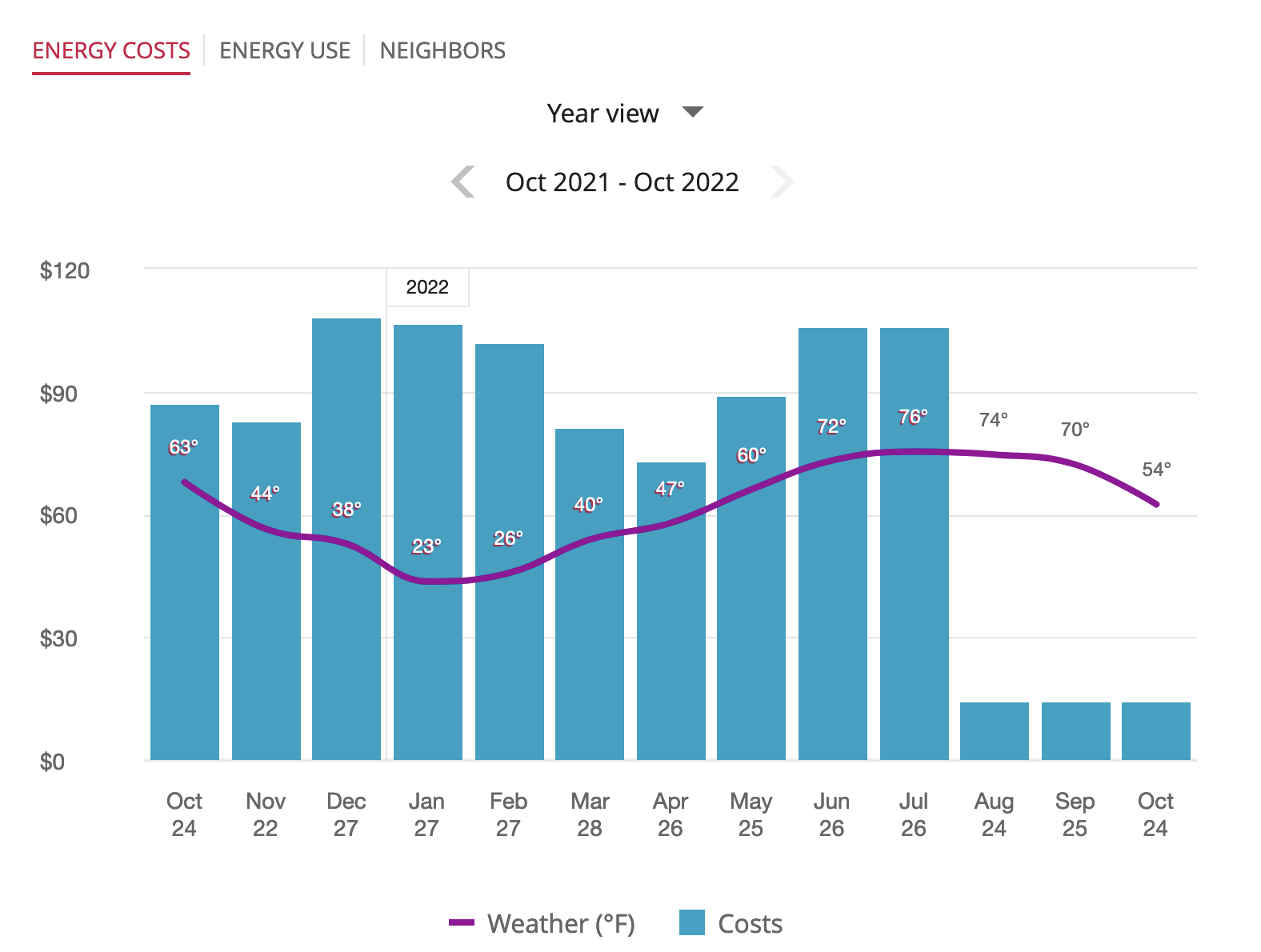
Our monthly ComEd bills dropped after our panels were installed in July
So how much did this cost us? Well first, it’s worth noting that we were able to get a number of tax credits and grants, notably:
- A 26% tax credit from the Federal Government for installing solar panels. We covered our electrical panel upgrade with this as well. This incentive can go up to 30%.
- A Solar Renewable Energy Credit (SREC) of $8,251 for committing to producing renewable energy over the next 15 years.
- A $10,000 Energy Efficiency Program grant from the Village of Oak Park for installing solar panels
Including the new roof, and counting our credits and grants, our total cost for this project was $12,463. With our anticipated savings on electricity, this system will pay for itself in less than nine years.
| Item | From |
Cost |
| Roof tear-off | BlueSky Roofing | $6,450 |
| 1" roof insulation | BlueSky Roofing | $1,975 |
| 8.76kW solar panel installation | Ailey Solar | $25,970 |
| 200A panel upgrade | Ailey Solar | $4,150 |
| 26% Federal Tax Incentive | Tax Credit (Federal) | -$7,831 |
| Solar Renewable Energy Credit (SREC) Income (taxable) | Credit (Illinois) | -$8,251 |
| Energy Efficiency Program | Matching Grant (Village of Oak Park) | -$10,000 |
| Total Cost | $12,463 |
Additionally, researchers from the Berkeley National Laboratory found that buyers were willing to pay a premium of $15,000 for a home with average-size solar panels (3.6 kilowatts, or 3,600 watts), compared with a similar home without one. Like upgrading our kitchen or bathrooms, this improvement has increased the value of our home. As a bonus, the panels are not easily visible from the street, which can be more appealing to some home buyers.
That’s all for now — thanks for reading! Stay tuned for my next post on our home electrification journey as we move on to electrifying our appliances.
Lessons learned
If you’re looking to install your own rooftop solar panels, I have a few lessons I learned that you’ll probably benefit from:
-
We could have installed up to 17 kilowatts of solar panels: While our 8.76 kilowatt system is enough to cover all of our current electricity needs, our roof and garage had space for up to 17 kilowatts of panels. As we continue to electrify our home, our electricity needs will increase, and thanks to Net metering, we would have been paid the difference in the meantime. One reason we sized our system smaller was due to a restriction by ComEd capping our project size to 110% of our current usage. However, in March 2022, this restriction was lifted. If we were to do it over, I would have gone with an even bigger system. If you want to get a feel for the size that’s possible for your home, look up your home on Project Sunroof and set the electric bill to max ($500).
-
We could have saved more money with the Inflation Reduction Act: The IRA, which will go into effect in 2023, provides a 30% tax credit for rooftop solar. This is higher than the 26% credit we got. If you do your project in 2023 or later, you’ll get this bigger credit.
-
Upgrading our electrical panel at the same time was a really good idea: Because we did it as part of your solar project, we got the same 26% tax credit for upgrading our electrical panel from 100 amps to 200 amps. This was necessary, as we will be plugging more things (EV charger, induction stove, heat pump) into our panel. With the IRA, this credit is now 30%.
-
There was not much benefit for us to install batteries: It’s often recommended to install batteries along with solar panels. The main benefit of this is resilience against outages. Considering we don’t often experience power outages at my house, this didn’t seem worth it. Your situation may be different, though.
-
There’s a chance you’ll need roof work done: As I outlined above, we had to get a new roof before installing panels. When talking to Ailey Solar, they said at least 10% of their clients need roof work even if they weren’t going solar, and another 10-30% have a roof that is okay today, but may not last the full minimum of 25 years (or more) of the lifetime of the solar system. In that case, you have a decision to make about being proactive with your roof - or to risk a costly panel removal and replacement.
-
We should have air sealed our attic space: Adding an inch of insulation to our roof was a good idea, but we missed an opportunity while it was open to insulate even more. We’ve since learned that our home is pretty drafty and one thing we’ll need to do before switching to a heat pump heater is to air seal our attic. Tom Bassett-Dilley wrote a good blog post (featuring our house!) about why this is necessary.
For the policy folks
A few notes for the policy folks who are reading:
-
Help residents understand and access the IRA benefits: the incentives provided by the Inflation Reduction Act is a real game changer for home electrification. Local governments should promote and explain these incentives and align their own climate action plans to enhance it. The Rewiring America IRA calculator is a great tool to share: https://www.rewiringamerica.org/app/ira-calculator
-
Increase the access to and scale of the Village Energy Efficiency Grant program: The $10,000 grant from the Village really made the economics of installing panels work. Because of the roof work we had to do, without it, our payback period would be closer to 20 years. This program’s $250k funding has already been exhausted, helping fund only 24 projects in the Village. This project needs to be greatly expanded if we’re going to make a dent in our 21,000 households.
-
Promote the Illinois Solar for All Program: In researching this blog post, I came across the Illinois Solar For All Program. If you make less than 80% of the area median income ($83,000/year for a family of four in Cook County) you are likely eligible for this program, a $50 million fund to pay for solar installations.
Resources
- Solar and heat pump installers in Oak Park: https://bit.ly/electrify-your-oak-park-home
- Decarb My State: look up where U.S. emissions come from, on a state-by-state basis: https://decarbmystate.com
- How much money will you save from the Inflation Reduction Act? https://www.rewiringamerica.org/app/ira-calculator
- Electrify Everything Home Guide: https://www.rewiringamerica.org/electrify-home-guide
- Project Sunroof: find the solar potential of your home: https://sunroof.withgoogle.com/
- Illinois Solar for All: $50 million grant program for installing solar panels for income-qualified households https://www.illinoissfa.com/
Want to get my next post in your inbox? Sign up for email updates
Email signup • derek@derekeder.com • © 2025 Derek Eder